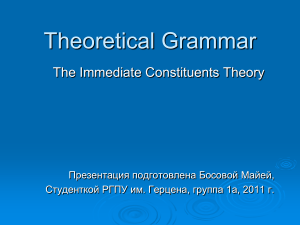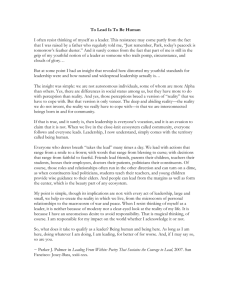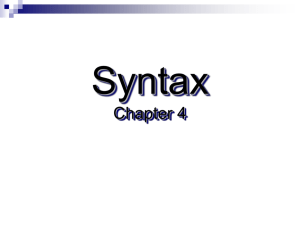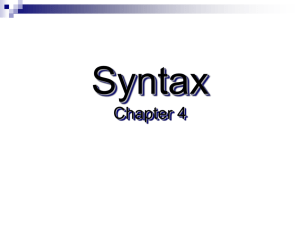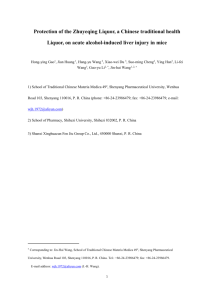Lecture 13 Notes
advertisement
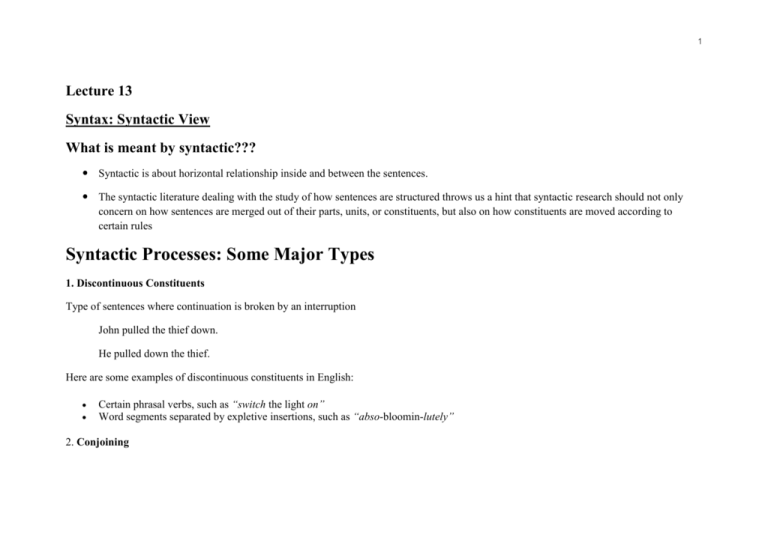
1
Lecture 13
Syntax: Syntactic View
What is meant by syntactic???
Syntactic is about horizontal relationship inside and between the sentences.
The syntactic literature dealing with the study of how sentences are structured throws us a hint that syntactic research should not only
concern on how sentences are merged out of their parts, units, or constituents, but also on how constituents are moved according to
certain rules
Syntactic Processes: Some Major Types
1. Discontinuous Constituents
Type of sentences where continuation is broken by an interruption
John pulled the thief down.
He pulled down the thief.
Here are some examples of discontinuous constituents in English:
Certain phrasal verbs, such as “switch the light on”
Word segments separated by expletive insertions, such as “abso-bloomin-lutely”
2. Conjoining
2
It occurs when elements are added or joined to other similar elements.
John, Juli and Mary will present a play.
John will sing, Juli will dance and Mary will play.
3. Embedding
It is embedding of a clause inside another one .
Conjoining occurs in co-ordinate clauses where as in sub-ordinate clauses there is embedding.
The boy is naughty.
The boy, who came here yesterday, is naughty.
Syntactic Analysis
Syntactic analysis is a science of structure which deals with the different structural elements of a language. There are different types of
analysis procedures:
1.
2.
3.
4.
5.
6.
7.
Immediate Constituent Analysis (ICA)
Ultimate Constituent Analysis (UCA)
Phrase Structure Grammar (PSG)
Transformational Generative Grammar (TGG)
Systemic (Functional) Grammar
Case Grammar
Stratificational Grammar
8. Tagmemics
3
Immediate Constituent Analysis (ICA)
Immediate Constituent Analysis is typically analytic and was developed with a view to working out a scientific ‘discovery procedure’ to
find out about the basic units of linguistics. The principle underlying theory is to cut a sentence into smaller parts till the smallest unit (ultimate
constituent), the morpheme, is reached.
The aim of Immediate Constituent Analysis is to analyse each utterance and each constituent into maximally independent sequences. The
ultimate constituents are the smallest meaningful units which any given constriction can be broken down to, consisting of a morpheme at the
morphological level and a word at the syntactic level.
This term was introduced by Bloomfield, who illustrated the way in which it was possible to take a sentence (he chose Poor John and ran
away) and split it up into two immediate constituents (Poor John and ran away), these being in turn analysable into further constituents (Poor and
John, and ran away). In other words, a sentence is seen not as a sequence or a "string" of elements, Poor + John + ran + away, but as being made
up of "layers" of constituents, each cutting point, or "node' in the diagram being given on identifying label. This was made clear in the form of a
"tree diagram", such as:
Sentence
Subject
Adjective
Noun
Predicate
Verb
Paricle
4
Poor
John
ran
away
ran
away
Or another write (Unlabelled IC analysis)
Poor
John
Adjective
Noun
Verb
Subject
Particle
Predicate
Sentence
And while techniques based on IC analysis are still used in most linguistics, they are now viewed as a very small part of what a grammar
has to do.
Example of unlabelled IC analysis.
The
large
currant
buns
in
the
window
taste very nice
5
Sentence
According to this model of analysis, sentences are not merely strings of words in an acceptable order; they are organized into successive
components consisting of words and groups of morphemes. In order to study the structure of a sentence, the structural linguists thought of
dividing a sentence into its ‘immediate constituents’ (or ICs). The principle involved was the cutting of a sentence into two, the further cutting of
these two parts into another two, and continuation of the segmentation until the smallest unit, the morpheme, was arrived at.
The units, or groups of units, into which a sentence can be sub-divided are called the constituents of a sentence. Immediate constituent
analysis attempts to breakdown constructions into sub-parts that are in some sense grammatically relevant. For example: My teacher will come
next year. We would like to ask two questions about this sentence.
- What are the constituents of this sentence?
- How are they organized?
This sentence is made up of six morphemes which can be defined as the minimal, significant, syntactic units. They are:
My teacher will come next year.
1
2
3 4
5
6
6
These morphemes are the ultimate constituents of the sentence. The expression ‘ultimate constituents’ implies that these elements are not
further analyzable at the syntactic level. These morphemes have been organized in a particular order in the sentence. A jumble of morphemes
thrown together at random would read like a non-sentence:
Year next come will teacher my.
It is obvious that sentences are not formed by stringing words and morphemes together at random. This sentence and in general any
sentence of the language may be represented as a particular arrangement of the minimal syntactic elements of which it is composed. Each human
language has certain permissible ways of organizing morphemes in its sentences. Each human language has a set of restrictions on what can go
where. The sequential ordering of the ultimate constituents shown above is called the linear structure of the sentence. Some of the constituents
tend to go together. The morphemes which are also word in this sentence, my and teacher will and come, next and year and tied together. These
groups of items which go together are called phrase. We can now say that these phrases are the constituents though not the ultimate constituents
of the sentence. The sentence is a string of phrases, it is made of phrases arranged in a particular order. This arrangement may be shown as:
My
teacher
will
come
next
year
This relationship can be shown in brackets as:
[(My teacher) (will come) (next year)]
These brackets indicate that the immediate constituents of the sentences are: my teacher and will come next year. The immediate
constituents of my teacher are ‘my’ and ‘teacher’. The immediate constituents of will come next year are ‘will come’ and ‘next year’. The
immediate constituents of will come are ‘will’ and ‘come’. The immediate constituents of next year are ‘next’ and ‘year’. These constituents are
7
arranged in a lineal structure. This type of analysis of sentences in terms of their immediate constituents is called immediate constituents
analysis.
Various notations have been used by linguists to represent the constituent structure of sentence. The most popular notation is what has
come to be known as tree diagram representation. A tree diagram representation of the sentence previously analyzed will look like this:
My
teacher
will come next
year
In joining morphemes we do not simply put them one after another like beads on a string. That is to say, grammatical order is not merely
linear sequence, but is another kind of order called hierarchical structure. In a hierarchy some units take precedence over and encompass others.
A sentence may be said to represent a hierarchy of structured units, each unit representing a string of elements. A sentence unit is made up of
classes of clause, which are made up of classes of phrases, which are made up of classes of word, which are made up of smaller constituents and
is a constituent in a larges construction. Sentences are made up of ‘layers’ of immediate constituents, each lower-level constituent being part of a
higher level constituent.
Another sentence ‘An old man with an umbrella chased the dog’ is made up of some natural groups. From one’s intuitive knowledge of
the language, the only way one may divide it into 2 groups is as follows:
An old man with an umbrella
1
chased the dog.
2
Now, 1 and 2 can be further divided into natural groups as follows:
8
An old man
with an umbrella
chased
1–A
1–B
2–A
the dog.
2–B
1 – A and 1 – B are the constituents of 1 while
2 – A and 2 – B are the constituents of 2.
The above information can be displayed in the form of a tree diagram as follows:
An old man with an umbrella chased the dog
An old man with an umbrella
An old man
chased the dog
with an umbrella
chased
the dog
Now, 1 – A, 1 – B, 2 – A, and 2 – B can be further sub-divided into smaller constituents as follows:
An old man
An
old man
old
man
with an umbrella
with
an umbrella
an
umbrella
9
chased
the dog
chase {past}
the
dog
Every constituent is a part of a higher natural word group and every constituent is further divided into lower constituents. This process
goes on until one arrives at the smallest constituent, a morpheme that can no longer be divided further. The full example of IC analysis of the
sentence is given below:
An old man with an umbrella chased the dog
An old man with an umbrella
An old man
An
old man
old
man
chased the dog
with an umbrella
with
an umbrella
an
chased
chase {past}
the dog
the
dog
umbrella
Simple bracketing or tree diagrams does not show the nature and functions of the constituents. This inadequacy of the model has been
removed by introducing the notion of labeling, as belonging to different grammatical constituents e.g. Noun Phrase, Verb Phrase, Adverbial, and
10
Prepositional Phrase, which can be further divided into categories such as Noun, Adjective, Verb and Tense Morpheme. Different methods are
used for showing the immediate constituents. Some of these are given below:
1. Segmentation using vertical lines
An I I old I I I man I I with I I I an I I I I umbrella I chase I I I d I I the I I I dog
2. Segmentation using brackets
[[[(An)] [(old) (man)]] [[with] [(an) (umbrella)]]] [[(chase) (d)] [(the)
(dog)]]]
3. Segmentation using a tree diagram
S
NP
NP
det.
Prep. Phr.
N
Prep.
Pred phr.
VG
NP
Tense
NP
V
det.
det.
Art.
Adj.
Art
N
Past
Art.
N
11
An
old
man
with
an umbrella
chase
the
dog
Segmentation using vertical lines, segmentation using brackets and segmentation using a tree diagram gives us an insight into the
syntactic functions for the ultimate and intermediate constituents of sentences.
Several models of IC analysis
There are several models of IC analysis.
1. To begin with, unlabelled bracketing was used with parentheses or box
diagrams.
the
man
who
live
s
near
my
house
is
a
famous
singer
12
[the] [man] [who]
[live] [s]
[near] [my] [house]
[is]
[a]
[famous] [singer]
Box diagram
The
man
who
live
s
near
my
house
is
a
famous
singer
13
2. Then labels like ‘modifier’, ‘head’, ‘qualifier’, were used to show the relationships among the constituents; this to some extent enriched
IC analysis since a mere cutting into ICs did not provide very many insights. The labels show the positionally defined functions of ICs.
The
man
who
lives
near
my
house
is
M
M
H
Modifier
H
Head
H
Qualifier
a
famous
singer
H
H
Q
M
H
M
H
H
H
M
Head
Notice that in exocentric constructions, it is not possible to use M, H, Q; functional labels like M, H, Q do not specify all grammatical
functions like subject, complement, object, etc.
14
3. Some linguistics used only category labels like noun phrases, verb phrases, prepositional phrases, etc. (NP, VP, Prep Ph, etc.). Here it is
difficult to table intermediary categories like ‘famous singer’ unless we abandon the binary cuts.
The
man
who
lives
near
my
house
is
Det
Prep
Rel
Det.
N
a
famous
singer
N
NP
V
Adj
Pro
Prep Ph
NP
N
Det
VP
V
NP
NP
VP
Some used both functional and category labels which made the analysis look more like the traditional one.
The
man
who
live
s
near
my
house
is
Det
a
N
famous
singer
15
Prep
Rel
Det.
N
N
Det
Prep Ph
Rel Cl
Sub
Adj
V
Pro
NP
NP
V
Pred.
NP – sub complement
16
4. This can also be shown in the form of the tree diagram.
S
NP
Det
Noun
the
man
VP
Rel Cl (Dependent sentence) V
NP
is
Rel Pro
VP
Det
Adj
N
who
V
Prep Ph
a
famous
singer
lives
Prep
NP
near
Det
my
N
house
Labels make the analysis more meaningful because they show grammatical relations more
clearly. Notice that in the diagram above there are two NPs. How re they different? They
have two different functions; (i) positionally they are different; (ii)the first NP enters into an
17
agreement relationship with the verb, but the presence or absence of the second NP depends
on the nature of the verb.
(a) Some more examples of IC Analysis
Old men and women
IC analysis I (meaning: old men and old women)
old
men
and
women
IC analysis II (meaning: women and old men)
old
men
and
women
(b) Labelled IC analysis
Pranee is walking in the park.
NP
VP
(Sub)
Aux
V
Prep. Phrase
Prep
D
N
18
Pranee
is
walk
ing
in
the
(c) A tree diagram
S
NP
VP
Noun
Aux.
Pranee
is
V
play
Prep Ph
ing
Prep
in
NP
Det
the
N
park
park.
19
Limitations of ICA
When the same string of words can be associated with more than one tree structure, it is
said to be structurally ambiguous.
“I bring new pens and pencil”
I + (bring + {new + [pens and pencil]})
I + (bring + {[new pens] + [and pencil]}
IC analysis does not clarify the nature and function of constituents words.
Solution:
To meet the last limitation, further IC analysis procedure was elaborated to clarify the
class, type and function of constituent words. *
Ultimate Constituent Analysis
The ultimate constituent analysis of a sentence considers morpheme rather than a word
(as in case of ICA) as ultimate constituent.
According to Hocket*, ‘morphemes are the elementary building blocks of the language in
its grammatical aspects’
The ultimate constituents - are the smallest meaningful units which any given
construction can be broken down to, consisting of, a morpheme at the morphological
level and a word at the syntactic level.
20
Ultimate Constituents Analysis
The boys played with the footballs.
s
NP
VP
Art
N plural
verb
past
The
boy -s
play
-ed
prep
with
art
the
N plural
football
-s
For ultimate constituent analysis, the end of a word can be a prefix or a suffix, beyond
which further division of a constituent is not possible.
21
